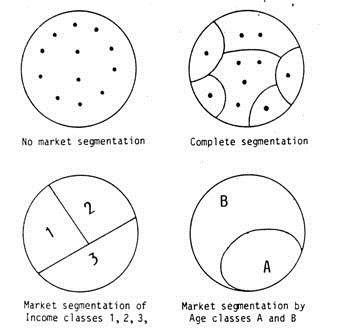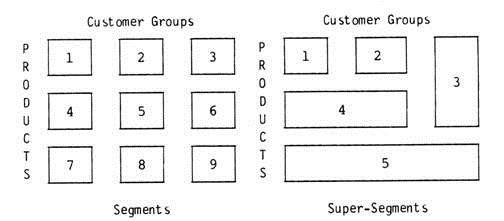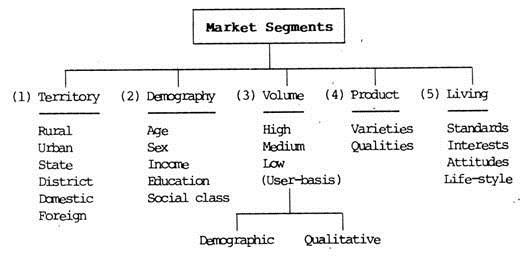Read this article to learn about Market Segmentation. Market segmentation is one of the most interesting and useful tools in marketing management. Here we will discuss various s definition of Market Segmentation, Concepts as explained by eminent authors, requirements of market segmentation and various advantages.
Market Segmentation: Definition, Concept, Requirements, How to, Types and Advantages
1. Market Segmentation – Definitions:
Some definitions on this term are given below:
1. “Market Segmentation is the act of dividing a market into distinct groups of buyers who might require separate products and/or marketing–mixes. The company identifies different ways to segment the market, develops profiles of the resulting market segments and evaluates each segments’ attractiveness.” [According to Philip Kolter].
2. “Market segments are grouping of customers according to such characteristics as income, age, degree of urbanisation, race, geographic location or education.” [According to Gundiff and Still].
Thus, we can state that whenever a market for a product or service consists of two or more buyers, the market is capable of being segmented, that is, divisible into meaningful buyer groups. A market represents a group of customers having common characteristics but two customers are seldom common in their income, tastes, preferences, and buying decisions.
The customers having similar traits or attributes are grouped in segments and so one segment is different from other segments. Market segmentation refers to the various segments of the market based on the common characteristics of the customers. In short, the grouping of buyers or segmenting the market is described as market segmentation.
As a part of this segregation or segmentation, target market for each group of customers is determined. That is, market-targeting is necessary to aim at the needs and desires of a particular group or groups of customers. For example, ‘North Star’ shoes of Bata Company aim at young men, college students and executives who exhibit a life style and tastes different from others.
These shoes are available in different price range and in different colours to suit different personality, purpose, and income. Bata Company also, produces traditional as well as novel types of shoes for ladies of different income and age, for children and for sports.
Let us take the case of ‘Vimal’ textiles which are of different shades, design, texture, smoothness, appearance, prices, etc. These varieties are necessary to meet the tastes, life style, and personality of the consumers of different but common types.
It can, therefore, be stated that unless the market segmentation based on the above factors is undertaken and a target market is determined, the marketing manager does not attain success and sales cannot be maximised.
The main reasons for market segmentation are:
(1) To maximise sales and profits,
(2) To attain the goals of marketing planning,
(3) To meet consumer satisfaction better,
(4) To counter competition, and
(5) To respond to technological changes effectively.
2. Market Segmentation – Concepts
Market segmentation is one of the most interesting and useful tools in marketing management. In modern economics, no company sells its products to individual customer because of mass production techniques. Goods and services are mass marketed.
But the problem is that the tastes and vents of the consumers vary- region to region, and even from person to person. There is no homogeneity. On the other hand, there is a great deal of diversity in regard to income, consumer psychographics, demography, family life style, social class, and cultural factor.
The following diagrams explain this point:
3. Market Segmentation – Requirements
We can identify the following three fundamental requirements for market segmentation:
1. Accessibility:
The segments must be accessible and served readily. It would be difficult to segment if the consumers are not accessible to advertising media.
2. Substantiability:
The coverage of the segments must be wide and large to warrant economies of scale. Otherwise it would be unprofitable to segment the market.
3. Action-Ability:
The segments of the market must be actionable. That means, these must be practicable, suitable, and attractive to the film. Too small segments are of no use for managerial programme and action.
4. Market Segmentation – How Market Segmentation is Done
According to Philip Kotler, a market coverage strategy is designed having regard to the following basic factors:
(1) Company resources
(2) Product homogeneity
(3) Product’ stage in life cycle
(4) Market homogeneity
(5) Competitive marketing strategy.
Typically, market segmentation is done keeping in view the following two aspects:
(a) Classification and division of customers into meaningful homogeneous groups; and
(b) Adoption of appropriate marketing mix after having a careful consideration of:
(i) Market factors like consumers, competition, distribution, and governmental regulations; and
(ii) Marketing factors concerning the product policy, pricing, branding, advertising, distribution channels, display, service, etc.
A lot of imagination, practical knowledge, and judgement are called for on the part of a marketing manager to do an effective market segmentation. The marketing manager, in this task, has to take the help of studies made and factual data generated by the marketing research team concerning the markets, competitors, customers, territorial’ demand-supply relationship and so on.
The following diagram shows how market segmentation is done typically in a simple way. The differences among the customers are ascertained with a view to choosing away them or marketing to them for the segmentation purposes.
5. Market Segmentation – Types
There are different types of market segments. Broadly speaking, we can have five classifications.
These are charted and discussed below in brief:
(1) The national and international markets comprise the territorial segmentation. The sales efforts of a company are usually directed on a territory basis and the sales personnel are allocated on this basis.
(2) The classification of customers into different homogenous groups, for market segmentation, is done on the basis of demographic similarities like age, sex, income, etc.
(3) Sometimes the market is segmented on the basis of high, medium and low users. Demographic characteristics also influence such segmentation.
(4) Market segmentation is, at times, resorted to based on the product differences and specialties. Colder countries require more winter garments, whereas industrial towns and cities with hot and temperate climate require air conditioners and refrigerators.
(5) Mode of living greatly influences market segmentation. The standards, attitudes, interests, education, etc. are the major determinants of a life style which affect the segmentation of a market.
6. Market Segmentation – Criteria or Bases
Gundiff and Still, eminent marketing researchers, state that the basis of market segmentation is highly characterised by product variations as well as the variations in the sensitivity of consumers. They further observe that the bases or criteria of consumer products markets are different from those of industrial products markets.
They have identified the following criteria for market segmentation:
The criteria for consumer products markets are:
1. Socio-Economic Criteria:
Age, sex, income, education, religion, race, family, etc.
2. Geographical Criteria:
Area, climate, population density, etc.
3. Personality Criteria:
Craziness for novelty with younger generation, high-brow attitudes, style of plain or high living, uniform dresses for a particular class, e.g. school going students, nurses, police officials, doctors, etc. .
4. Consumer Behaviour Criteria:
Usage habits, motives, and brand loyalty dictate the patterns of consumer behaviour and thereby the markets.
To cite few examples, the cloth- market is segmented mostly on the basis of age, lipstick or beauty aids and shaving cream on the basis of sex; VCR, Radio, T. V. and Refrigerators on income basis, books on target students and educationists, speciality dresses according to race or religion, cooking-range on the basis of family size, etc.
In nutshell, consumer products and their market segments are to be addressed and determined in the light of the consumers’ needs, behaviour, habits, customs and preferences.
The criteria for industrial products markets are:
(1) Business Activity Criteria:
The nature and type of activities undertaken i.e., manufacturing, or trading, or services offered determine the market segments. For example, banking company’s market is segmented in merchant banking, underwriting, foreign receipts or remittances, personal banking.
A separate branch or division is usually formed for each segment representing a specific activity. This may again be segmented into deposit mobilisation division and lending division. Similarly, an insurance business is segmented into distinct activities such as fire, marine, life, etc.
(2) Buying Criteria:
Industrial consumers are regular buyers for stores, spares, tools, equipment’s including heavy machines. The industries even though scattered over a country are characterised by their concentration as to type of activity in certain places or zones. This phenomenon requires consideration for market segmentation by the firms producing and selling industrial- products.
(3) Geographical Criteria:
Industrial products marketing and its segmentation are greatly influenced by geographic concentration of industries. For example, mining equipment’s and tools market is segmented by the location of mines and quarries; ship-building and boat-making materials market is segmented in the coastal and riverine areas; hotels and motels are segmented in industrial towns, cities, and places of tourists’ attraction.
(4) Consumer/User-Size Criteria:
The scale of operations varies according to the size of industries. So, some industrial consumers are large while others are small. Hence, the industrial market segmentation depends on this.
7. Market Segmentation – Advantages
An appropriate market segmentation offers the following advantages to- a firm:
1. Product-Market Adjustment:
A firm having producing and selling operations gets an understanding of the nature, type, and complexities of the market. It can adopt marketing policies and revise strategies to attract the maximum number of customers by an appropriate marketing mix to suit the requirements of a particular market segment.
2. Sales Estimation:
The marketing management in-general and sales organisation in particular are in a position to estimate existing market and future sales potential because of segmentation. Marketing planning and strategy can be readjusted depending on the consumers’ behaviour in a segment.
3. Budget Allocation:
The marketing prospects of a segment being known and estimated in advance, the marketing budget can be prepared arid; operated. The budget allocations can be suitably modified in consideration of the marketing efforts put forth.
4. Marketing Programme Implementation:
The markets being segmented and the opportunities and threats being known, suitable marketing programme can be developed and implemented in an effective manner.
5. Competitive Advantage:
A firm knows its rivals and competitors of the market segments served by it. It can design and practice different strategies for different segments to achieve competitive advantage.
6. Segment-Wise Results Evaluation:
The strengths and weaknesses, and opportunities and threats of segmented markets are different, and thus, the performance of each market segment can be compared and evaluated in terms of profits, profitability, turnover, costs of administration/distribution/inventory/promotion etc.


